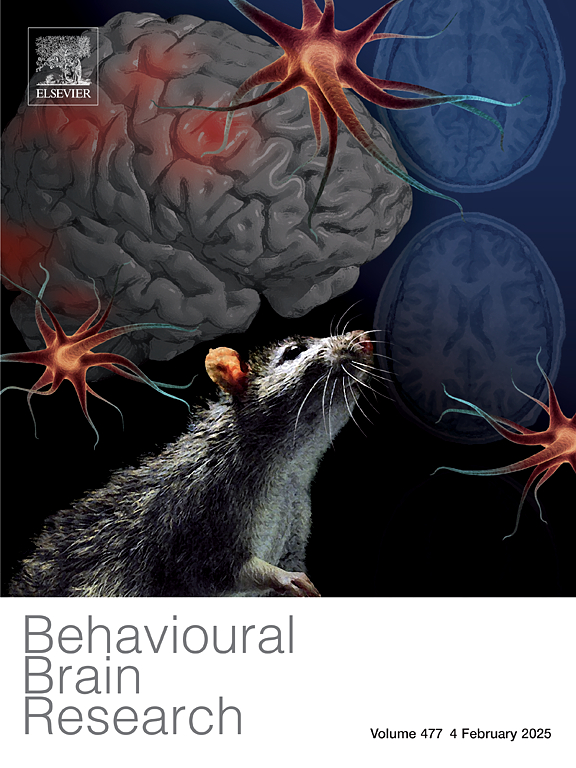环境咖啡因引发鲤的氧化应激和行为改变:对神经毒性的见解
IF 2.3
3区 心理学
Q2 BEHAVIORAL SCIENCES
引用次数: 0
摘要
咖啡因(CAF)被归类为中枢神经系统(CNS)兴奋剂,其效果因种类、暴露时间和剂量等因素而异。中枢神经系统调节重要的生理过程,由于其高脂质含量,对环境污染物,特别是氧化应激非常敏感。本研究探讨了CAF(一种已知的中枢神经系统兴奋剂)在不同暴露水平(0、500、1250、1750和2500 ng/L)下对鲤幼鱼的影响。采用整体方法,我们评估了氧化应激标志物,如脂质过氧化(LPX),氢过氧化物含量(HPC),蛋白质羰基含量(PCC)和抗氧化反应超氧化物歧化酶(SOD)和过氧化氢酶(CAT),以及乙酰胆甾醇酶(AChE)活性,行为模式(Novel Tank Test, Dark &;光试验)、组织学变化(H&;E染色)和基因表达(腺苷受体A1、腺苷受体A2A、serca、ryr、i3pr)。我们的研究结果表明,CAF浓度的增加与鲤鱼大脑中氧化和抗氧化生物标志物水平的升高有关。具体来说,乙酰胆碱酯酶活性降低,反映神经毒性。在行为上,CAF表现出双相影响:在较低浓度(500 ng/L)下,它促进运动并减少焦虑,而在浓度高于2500 ng/L时,它抑制运动活动并增加焦虑样行为。值得注意的是,最高浓度(2500 ng/L)导致了显著的组织病理学改变,病理改变的发生率为45.9% %,主要是脑端和视顶叶的空泡化。基因表达分析显示,腺苷受体A1和腺苷受体A2A表达上调,提示CAF机制的变化是基于受体相互作用。此外,参与Ca2 +信号(serca, ryr, i3pr)的基因也有正向调节,这些基因对细胞稳态至关重要,并与细胞肿瘤有关。该研究最终表明,虽然低剂量的CAF对运动能力有有益影响,但高剂量会导致明显的神经毒性,表现为氧化应激、酶抑制、焦虑样行为、大脑组织病理学和基因表达失调。这些发现为水生脊椎动物暴露于环境CAF的剂量依赖性神经毒性效应提供了重要见解。本文章由计算机程序翻译,如有差异,请以英文原文为准。
Environmental caffeine triggers oxidative stress and behavioral changes in Cyprinus carpio: Insights into neurotoxicity
Caffeine (CAF) is categorized as a central nervous system (CNS) stimulant, with effects varying based on factors like species, exposure duration, and dosage. The CNS regulates vital physiological processes and is notably sensitive to environmental pollutants, particularly oxidative stress due to its high lipid content. This study investigates the impact of CAF a known CNS stimulant, on juvenile Cyprinus carpio at various exposure levels (0, 500, 1250, 1750 and 2500 ng/L). Employing a holistic approach, we assessed the oxidative stress markers such as lipid peroxidation (LPX), hydroperoxides content (HPC), protein carbonyl content (PCC) and antioxidant responses superoxide dismutase (SOD) and catalase (CAT), alongside AChsterase (AChE) activity, behavioral patterns (Novel Tank Test, Dark & Light Test), histological changes (H&E staining), and gene expression (adenosine receptor A1, adenosine receptor A2A, serca, ryr, i3pr). Our findings indicate that increasing CAF concentrations correlate with heightened oxidative and antioxidant biomarker levels in the carp brain. Specifically, AChE activity diminished, reflecting neurotoxicity. Behaviorally, CAF displayed a biphasic influence: at lower concentrations (500 ng/L), it promoted locomotion and reduced anxiety, whereas at concentrations above 2500 ng/L, it suppressed locomotor activity and heightened anxiety-like behaviors. Notably, the highest concentration (2500 ng/L) resulted in significant histopathological changes, with a 45.9 % incidence of pathological alterations, predominantly vacuolization in the telencephalon and optic tectum. Gene expression analysis revealed an upregulation of adenosine receptor A1 and adenosine receptor A2A, indicating variations in the CAF mechanism based on receptor interaction. Additionally, there was a positive regulation of genes involved in Ca2 + signaling (serca, ryr, i3pr), crucial for cellular homeostasis and implicated in cellular neoplasia’s. The study conclusively demonstrates that while low CAF doses can have beneficial effects on mobility, higher doses lead to pronounced neurotoxicity, indicated by oxidative stress, enzymatic inhibition, anxiety-like behavior, cerebral histopathology, and gene expression dysregulation. These findings provide critical insights into the dose-dependent neurotoxic effects of environmental CAF exposure in aquatic vertebrates.
求助全文
通过发布文献求助,成功后即可免费获取论文全文。
去求助
来源期刊

Behavioural Brain Research
医学-行为科学
CiteScore
5.60
自引率
0.00%
发文量
383
审稿时长
61 days
期刊介绍:
Behavioural Brain Research is an international, interdisciplinary journal dedicated to the publication of articles in the field of behavioural neuroscience, broadly defined. Contributions from the entire range of disciplines that comprise the neurosciences, behavioural sciences or cognitive sciences are appropriate, as long as the goal is to delineate the neural mechanisms underlying behaviour. Thus, studies may range from neurophysiological, neuroanatomical, neurochemical or neuropharmacological analysis of brain-behaviour relations, including the use of molecular genetic or behavioural genetic approaches, to studies that involve the use of brain imaging techniques, to neuroethological studies. Reports of original research, of major methodological advances, or of novel conceptual approaches are all encouraged. The journal will also consider critical reviews on selected topics.
 求助内容:
求助内容: 应助结果提醒方式:
应助结果提醒方式:


